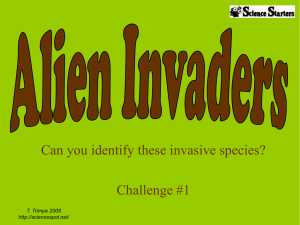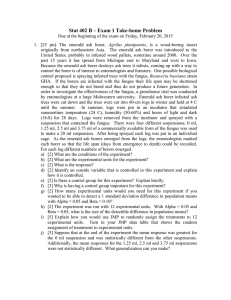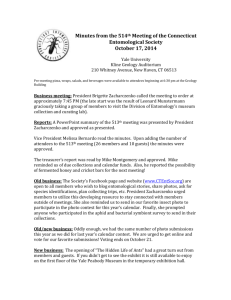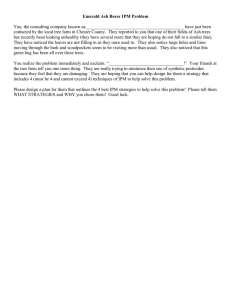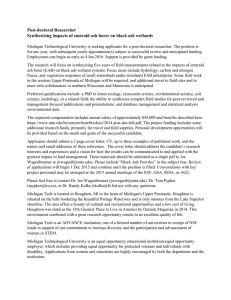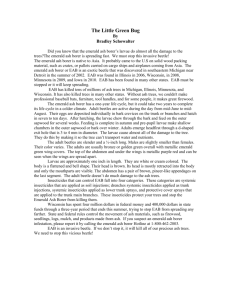A Visual Guide to Detecting Emerald Ash Borer Damage
advertisement
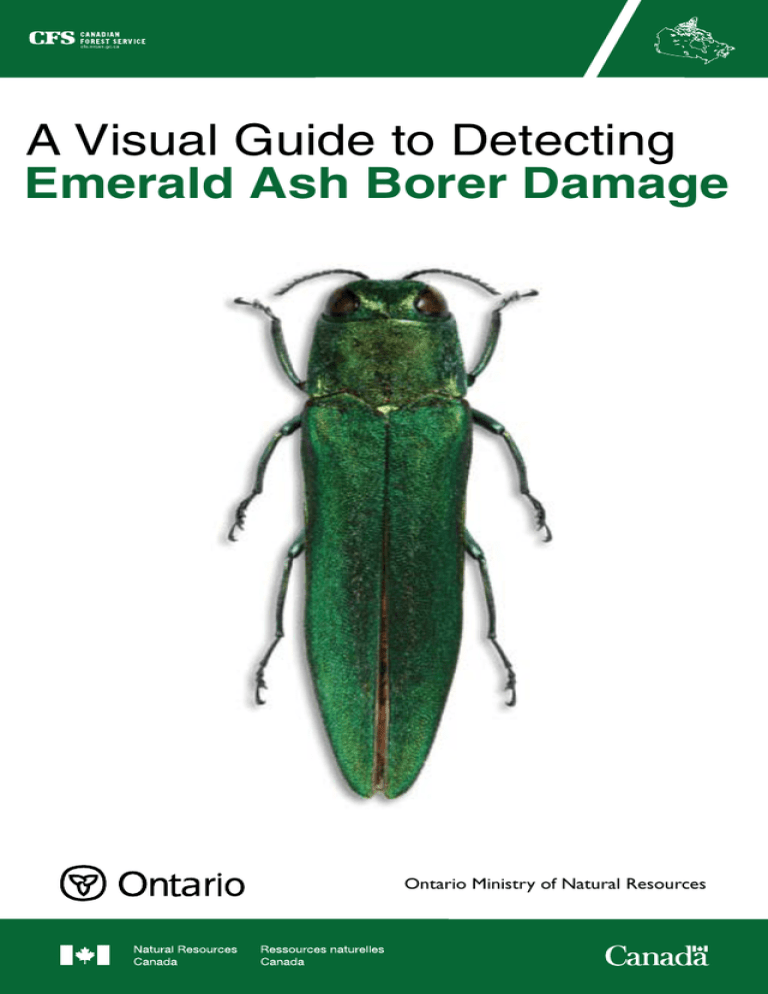
cfs.nrcan.gc.ca A Visual Guide to Detecting Emerald Ash Borer Damage Ontario Ministry of Natural Resources Library and Archives Canada Cataloguing in Publication A visual guide to detecting emerald ash borer damage / Peter de Groot ... [et al.]. Issued also in French under title: Guide visuel pour la détection des dommages causés par l’agrile du frêne. ISBN 0-662-43152-9 Cat. no.: Fo124-6/2006E 1. Ash (Plants)--Diseases and pests--Identification. 2. Emerald ash borer. I. De Groot, P. (Peter) II. Great Lakes Forestry Centre SB608.A77V57 2006 634.9’7387 C2006-980112-6 Copies of this publication are available at no charge from: Canadian Forest Service, Great Lakes Forestry Centre 1219 Queen Street East, Sault Ste. Marie, Ontario, P6A 2E5 (705) 949-9461 © Her Majesty the Queen in Right of Canada 2006 Cover photo by: Klaus Bolte, Natural Resources Canada A Visual Guide to Detecting Emerald Ash Borer Damage Prepared by Peter de Groot1, William D. Biggs1, D. Barry Lyons1, Taylor Scarr2, Ed Czerwinski3, Hugh J. Evans1, Wayne Ingram2, and Ken Marchant4 1 Natural Resources Canada, Canadian Forest Service, Great Lakes Forestry Centre, 1219 Queen St. E, Sault Ste. Marie, Ontario, P6A 2E5 2 Ontario Ministry of Natural Resources, Forest Management Branch, Forest Health and Silviculture Section, Suite 400, 70 Foster Dr., Sault Ste Marie, Ontario, P6A 6V5 3 Ontario Ministry of Natural Resources, Forest Management Branch, Forest Health and Silviculture Section, 300 Water St, Box 7000, Peterborough, Ontario, K9J 8M5 4 Canadian Food Inspection Agency, Ontario Area, Network specialist - Emerald ash borer, 174 Stone Road West,Guelph, Ontario, N1G 4S9 TABLE OF CONTENTS INTRODUCTION.................................................................1 HOW TO USE THIS GUIDE...............................................2 INSECT LIFE STAGES...........................................................3 Adult............................................................................................. 3 Egg................................................................................................. 3 Larva............................................................................................. 4 Pupa............................................................................................... 4 SIGNS AND SYMPTOMS....................................................5 Insect Signs.................................................................................. 5 Larval gallery.................................................................................. 5 Exit hole.......................................................................................... 7 Leaf notch....................................................................................... 7 Other signs.................................................................................. 8 Tree Symptoms........................................................................... 9 Epicormic shoots........................................................................... 9 Bark deformities............................................................................ 10 Yellow foliage, dead branches, and thin tree crowns........... 11 Heavy seed production................................................................ 11 Trees in decline........................................................................... 12 Tree 1................................................................................12 Tree 2................................................................................13 Tree 3................................................................................14 Tree 4................................................................................15 WHAT CAN I DO TO HELP?............................................16 WHOM DO I CONTACT..................................................16 INTRODUCTION The emerald ash borer (Agrilus planipennis Fairmaire) is a shiny emerald green beetle that kills living ash trees. Ash (genus Fraxinus) is found throughout many of the forests in eastern North America and it is a commonly planted street and landscape tree. The beetle arrived in North America from Asia and was first noticed in 2002 in Detroit, Michigan, and in Windsor, Ontario. It was present in these areas for a number of years before being discovered, and has also been detected in southwestern Ontario, Michigan, Ohio, and Indiana. It is likely that this beetle will spread by natural means and through movement of ash products such as firewood, nursery stock, and logs. The beetle is a very serious pest and already has killed millions of trees. The earliest possible detection of this insect is essential to help reduce its spread and damage. This guidebook will help people interested in tree care to detect trees that have been attacked and damaged by the emerald ash borer. Ideally, it is best to find beetles in an area before they harm or kill trees. Unfortunately, this is not easy, and for now, we can only rely on the visual signs and symptoms as a guide to detect damage by the emerald ash borer. 1 HOW TO USE THIS GUIDE The guidebook has three sections. You can start anywhere. The blue section is about the emerald ash borer itself and provides pictures and a brief description of the insect’s life stages. The green section is about the damage done to trees by the beetles. This section shows pictures of the various signs of physical damage to a tree by actions of the insect and includes larval galleries, exit holes from a tree, and feeding notches in leaves. The section also includes the symptoms expressed by the tree in response to insect attack. This is what you will likely see first and includes premature yellowing of foliage, dead branches, thinning crowns, bark cracks, and/or unusual shoots growing along the stem of the tree. We also show pictures of bark damaged by woodpeckers and squirrels, which feed on the insects. In the last part of this section, a series of pictures shows the various symptoms expressed by trees as they declined over time. The red section provides you with advice on things you can do to help and whom you should contact if you suspect that a tree has the emerald ash borer. Caution: The insect signs and tree symptoms described here are not foolproof. That is, other insects, diseases, and problems can look the same and cause similar symptoms. It is very important that you call an expert to confirm that emerald ash borer is present. 2 INSECT LIFE STAGES The emerald ash borer has four life stages: adult, egg, larva and pupa. Adult The adult beetle has a shiny emerald or coppery green-coloured body. The eyes are large, bronze or black, and kidney-shaped. The body is narrow, about 3 to 3.5 mm wide, and about 7 to 8 mm long. Adults can be seen on or near ash trees from early June to the end of August. The adults feed along the margins of ash leaves, they mate, and then the females deposit their eggs singly in bark crevices or under bark scales. Egg The egg is flat, oval-shaped, and small (0.6 by 1 mm). Freshly laid eggs are creamy yellow and older eggs are reddish brown. The eggs are hard to see because they are tiny and hidden in bark crevices or under bark scales. 3 INSECT LIFE STAGES Larva A fully grown larva is about 26 to 32 mm long, with a creamy white to light greenish body and small brown head. Larvae feed between the sapwood and bark along the entire length of the tree’s trunk and on branches more than 2 cm in diameter. Larvae can be found under the bark during the summer months, although some can be found all year round. It is the feeding by the larvae (there can be hundreds even thousands of larvae in a single tree) that cuts off the flow of nutrients, which eventually kills the tree. As the larva grows, it moults four times. At the end of the fourth moult, before becoming a pupa, the larva is J-shaped and has a slightly thicker and shorter body. This stage is called a prepupae and is first observed in September. Most of the population spends the winter in this stage. Pupa The pupa is the transformation stage of an insect’s development between a larva and an adult. A pupa is initially beige coloured, and then darkens, as it develops and begins to look like an adult. The pupa is found under the bark from late April until mid-July. 4 SIGNS AND SYMPTOMS Signs and symptoms are indicators of insect attack. A sign is physical damage to a tree, such as a gallery, a hole, or a feeding notch in the leaf, resulting from attack by an insect. A symptom is a tree’s response to insect attack and includes premature yellowing of foliage, dead branches, thinning crowns, or bark cracks. As cautioned in the introduction, similar signs and symptoms can be caused by other pests, drought, or cold stress and therefore you need an expert to verify that emerald ash borer is present in the tree. New infestations of emerald ash borer are very difficult to detect. Usually by the time you detect these signs and symptoms, the tree is already heavily infested. However, if you identify these infested trees, there may be time to protect lightly infested trees in the area or slow the spread to other areas. This is why early detection is so important. Insect Signs Larval gallery: When the larva feeds between the bark and sapwood, it makes an S-shaped, “zig-zag,” or serpentine gallery. When the young larva enters the wood to begin feeding, it may move up or down the tree bole or branch. You can tell which way it moved by looking at the width of the gallery: as the larva gets bigger so does the width of the gallery. In this picture, the larva moved down the tree (from the top of the picture to the bottom). 5 Insect Signs A Peeling the bark away from a tree will reveal several galleries (A). In very heavy infestations, the galleries cover almost the entire sapwood (B), and the high number of galleries and insects obscures the typical serpentine gallery. A tree that has been attacked more than one year will have old galleries (C). In this picture, you can see two old galleries: a large one to the left and a smaller one to its upper right. An old gallery has rounded ridges on the sides (callus tissue) caused by the new growth of the tree. As you can see in this picture, new galleries were engraved on the current year’s growth. B C 6 Insect Signs A Exit hole: As a new adult exits B Leaf notch: The new adult feeds the tree, it chews a D-shaped hole in the bark (A). The holes are slightly bigger than the adult, and are about 3.5 to 4 mm wide. These D-shaped holes are unique to the group of beetles to which the emerald ash borer belongs. Although the holes are a very good indication that the emerald ash borer has infested the tree, it is not an absolute proof because there are other beetles that can cause similar holes. Nevertheless if you see these holes and the Sshaped galleries underneath the bark, report your discovery. on ash leaves and cuts notches on the side of the leaf (B). C When insect populations are high, defoliation by adults (C) will be noticeable and may result in tree crowns appearing ragged. 7 Other signs B A C When a tree is infested, birds and other animals can damage the bark to feed on the larvae. Various species of woodpeckers feed on emerald ash borer and produce holes in the bark surrounded by light coloured patches (A, B). Occasionally black and grey squirrels will feed on the larvae and leave ragged strips of bark on the stem (C). Look closely where the bark has been stripped and you will see the S-shaped galleries produced by the larvae (see arrow). 8 Tree Symptoms A B Epicormic shoots: These shoots are also called suckers, water sprouts or witches brooms and are produced on the tree trunk and roots when the tree is under stress. They can sometimes be found in the tree crown, on stems and on larger branches (A, B, C). Not all trees attacked by the emerald ash borer develop epicormic shoots. However, under the right conditions and intensity of attack by the beetle, they can develop and grow quickly. C 9 Tree Symptoms B A C Bark deformities : Vertical splits or cracks in the bark over larval galleries are commonly seen on the trunk and branches of infested trees (A, B). Note in picture (A), the epicormic shoots to the left of the bark split, and in picture (B), the D-shaped exit holes (see arrows). Bark splits are often 5 to 15 cm long. On young trees with thin bark (C), the bark over a gallery turns pinkish brown and dries (see arrow). 10 Tree Symptoms B A Yellow foliage, dead branches, and thin tree crowns: Feeding by the larvae eventually kills branches. As the branches begin to die, the foliage turns yellow, wilts and falls off leaving bare branches (A). In picture (B), you can see the thinning crowns as well as epicormic shoots on the trunk. C D Heavy seed production: A tree under severe stress can produce an abundant seed crop, which yields few viable seeds (C). In picture (D), note the very heavy seed crop on the small tree, the thin tree crown, and the epicormic shoots on the trunk. 11 Trees in Decline The following pages show how four trees declined over time because of attack by the emerald ash borer. B A C Tree 1: This tree was first inspected on 16 June 2003 (A) and showed no signs or symptoms of attack by the emerald ash borer. By 21 August, some premature yellowish foliage was evident in the upper crown (B). A year later (10 August 2004), the crown had become very thin (C), yellowish foliage was present, and epicormic shoots were visible at the base of the tree. 12 Trees in Decline A B C D Tree 2: This tree was first inspected on 24 June 2003 and showed early symptoms of a thinning crown near the top (A). By 21 August, premature yellowish foliage was seen in the upper crown (B). A year later (8 June 2004), the whole crown was very thin and dead branches appeared (C). By 18 September, more of the crown had died (D), and little foliage remained on the tree. 13 Trees in Decline B A C Tree 3: This large tree was examined on 16 June 2003 (A) and showed faint symptoms of a thinning crown caused by the emerald ash borer. A year later (8 June 2004), the crown had thinned and a large clump of epicormic shoots was visible where the trunk began to fork into branches (B). About six weeks later (20 July), the crown was even thinner and the tree was well on the way to dying (C). 14 Trees in Decline A B C D Tree 4: This tree was first inspected on 21 July 2003 (A) and showed no apparent signs or symptoms of attack by the emerald ash borer. A year later (20 July 2004), the crown was considerably thinner and foliage was a yellowish green (B). Small epicormic shoots were visible on the main stem and where the tree forked into branches. A few weeks later, the crown had become very thin (C), and by 17 September 2004, the crown was extremely thin, with epicormic shoots becoming quite prominent (D). 15 WHAT CAN I DO TO HELP? If you think you have found the emerald ash borer: • Record the location of the tree, • Record the Signs and Symptoms you observed, • Collect an adult specimen, keep it in a container in a freezer (to kill and preserve it), and • Contact the Canadian Food Inspection Agency. If you plan to move ash firewood, nursery stock or logs, inspect them for signs of emerald ash borer. Do not move infested material. Please note that in Canada and the United States, areas known to be infested with emerald ash borer are under strict regulations and control, and movement of regulated commodities is restricted by laws. DO NOT MOVE INFESTED MATERIAL OUT OF AN AREA THAT IS REGULATED. WHOM DO I CONTACT? If you have found a beetle or damage that you suspect is emerald ash borer, contact a Plant Health Inspector at local Canadian Food Inspection Agency Office. You can also call the Emerald Ash Borer at 1-866-463-6017, or visit the Canadian Food Inspection Agency Web site at: http://www.inspection.gc.ca. 16
